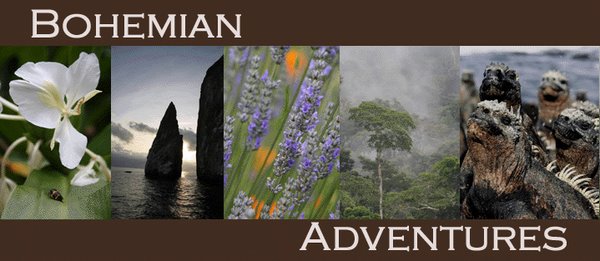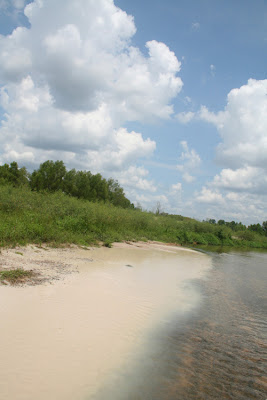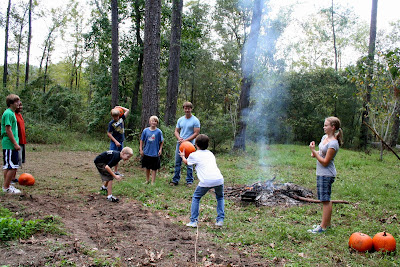 This is just sad, but this is the best grizzly picture I could find! This was a grizzly eating vegetation in Yosemite National Park. Everywhere I go, I see bears. I think they're my totem animal! I have seen them in Alaska, at Glacier NP, at Yosemite, at Yellowstone, oh and the black bears I saw when writing an article on them in Louisiana...and then I studied grizzlies when I was at A&M grad school (see below)!
This is just sad, but this is the best grizzly picture I could find! This was a grizzly eating vegetation in Yosemite National Park. Everywhere I go, I see bears. I think they're my totem animal! I have seen them in Alaska, at Glacier NP, at Yosemite, at Yellowstone, oh and the black bears I saw when writing an article on them in Louisiana...and then I studied grizzlies when I was at A&M grad school (see below)!
Copyright (c) 2007 Wendee Holtcamp
Since someone commented on bias in the media on my last post, I want to start talking about this issue a bit more because it's near and dear to my heart. When I spent 2 years earning a Information Technology in Science - ITS - Certificate from Texas A&M (a collaboration of the Departments of Education and Department of Science), critical thinking was my main interest. (I worked in Larry Griffing's lab studying the behavior of grizzly bears at McNeil River, Alaska via remote camera, before transferring to Rice).
While working on the ITS Certificate, which was part of my doctoral studies, I developed an "Evolution in Action" Excel workbook. I then used this tool to teach my Biology students at Kingwood College (now Lonestar College) scientific/critical thinking skills and also to introduce students to evolution. Students would watch video of grizzly bears engaged in various behaviors, including fishing for salmon, fighting with one another, and infanticide (in this case, a male bear killed a female bear's cub), while thinking about the questions, "Why might aggressive behavior have evolved in grizzlies? Is the reason different for female versus male bears?"
(I just uploaded it here - Evolution in Action. It's an Excel file and the link will open a window asking you to open in the browser or to save it to your computer where you can view it). After developing the workbook and using it in class, I did a study analyzing whether the workbook helped enhance student critical thinking (see my publication, "Grizzly Bears, Evolution, and Critical Thinking: Analyzing a Scaffolding IT for Teaching").
The workbook involves several different exercises but the last one was to analyze various print sources of information on grizzly bears - book chapters from various authors, a website, a scientific publication. There's a lot of controversy and misinformation surrounding grizzlies! After reading each source, they would then answer the following questions (below), and fill out a worksheet that assigned numerical values to their answers. This enabled them to rank the reliability of that source of information.
These are the questions:
- Are the authors' names and credentials listed on the publication?
- Does the info source provide more than one viewpoint or hypothesis?
- Are specific studies mentioned or cited in the text? (Do not give a YES answer if the article contains general phrases like "studies indicate" or "research shows" unless the article/source explicitly mentions a specific study and researcher mentioned).
- Does the paper test a prediction?
- Are the authors trying persuade you to accept a particular viewpoint?
- When was it published? (decreasing points for older pubs)
- Is the article or website sponsored by a company or by advertising?
- Do the authors blatantly or implicitly insult other perspectives?
- Does the perspective presented seem exaggerated or extreme?
- What is the purpose of the publication? (inform/share data; Disclose information; persuade; sell or entice)
By answering those questions and entering a numerical value (explained in the workbook) to each answer, they would come up with a numerical way to judge and analyze the reliability of a particular news source. I'd love to develop this tool more and make it available to the public. It's far from complete or fully comprehensive, but it's a start. (The video links won't work in the online version, unfortunately, and you have to click on the tabs at the bottom to get to the different "Exercises.")
I also have some views on objectivity in journalism that may differ from the typical J-school trained journalist because, well, I'm not one. I'm a science-educated writer who covers wildlife, the environment, conservation, and outdoor travel. I outlined some of my thoughts on Objectivity in Journalism when I gave an invited lecture at the University of North Texas' 2007 Nature Writing Symposium.
Magazine writing, especially for magazines mostly published by nonprofit organizations, don't necessarily hold to the same standards as, say, the strict guidelines of the New York Times. There is a difference between being fair and truthful, and doing the whole "present both sides" thing which in many ways can be a sham, particularly when journalists present two or more sides on an issue when there are NOT two sides! Do we give equal time to lunatics or fringe ideas? Doing so only makes their ideas seem more accepted unless they're clearly labeled as such.
But worse, in my opinion, is when a news source gives the illusion of being unbiased, but clearly is! I believe that sources providing information should put their biases out there on the table. Most know Fox News has a conservative bent -but they don't tell this clearly to their listeners. Some people believe the media has a liberal bias but present information as if they don't. It is a problem when news sources act "as if" they are not biased but bias creeps in.
We should know that a magazine published by a wildlife nonprofit is going to not run certain stories, but that does not mean the stories they run are not accurate, fact-checked, and presented with attention to both sides of an argument. However they may come out a bit more persuasively argued toward one side of the argument than another. But when the same information is presented in say a conservation magazine, the New York Times, and various other sources of news and information but not in a right-leaning news source, that is when you should be concerned that maybe the story has merit. There's no doubt that while the internet has revolutionized the world into an information age, one of the downfalls is that so much information can be overwhelming and it becomes difficult to separate the wheat from the chaff.
Another thing is that there are a lot of "thinktanks" and organizations with great-sounding names ("Center for Truth" - I made that up - but that kind of thing) - but in reality they are funded by particular groups with very specific agendas. When they're quoted in newspaper articles without that article clearly addressing this issue, it passes along "expert" quotes when that expert may just be paid to spout off a certain perspective (and most likely they believe it too, or they probably would not work for that organization). But sometimes, it takes digging to find these things out, and most people don't take time to dig. Who has time? But with the internet it's often not that difficult. Sometimes journalists must do FOIA (Freedom of Information Act) requests - demanding governments release information that should be public but that they don't want to release - and then writing expose's to expose some of the more "hidden agendas." FOIA requests are not a tool your average citizen typically uses, but why you should indeed pay attention to the more prestigious newspapers and news sources. They do their homework and have high standards. They're not perfect, but in my experience, journalists take great pride in their work and being the "4th branch" of a healthy democracy.
I think that bias still does creep into supposed bastions of objectivity like the NY Times, but that does not mean that one should not still read it and pay attention. Just have a critically thinking mind when doing so. Those who pretend to not have bias may just be fooling themselves. We all have biases. The trick is to do our best to understand and make clear our biases, even while still doing our best to write truthfully and accurately. I believe it's better to be clear about biases than to pretend one does not have them.
However when it comes to science - and this is one of the most misunderstood things in society I believe - the whole field of science, the scientific method and the whole process of science (developed during the Scientific Revolution) was designed specifically to REMOVE bias from the the practioner's research so that scientists could reveal facts and ultimately truth. In science, this is done through the various things, including the scientific method, double-blind experiments, the use of statistics to analyze data (rather than merely philosophical reasoning and logic), and the peer-review system of scientific publication.
 I love this photo. One of Savannah's friends took this shot actually, not me. They got their face painted at our church picnic and all three girls got dots all over their faces. It was cute! She has beautiful eyes! :)
I love this photo. One of Savannah's friends took this shot actually, not me. They got their face painted at our church picnic and all three girls got dots all over their faces. It was cute! She has beautiful eyes! :) This is super old but I was just randonly going through pics and thought this is cute - wonder twin powers, activate! This is Elise (aka Stinky - ha ha!) and I at a Christmas party I had at my house last year.
This is super old but I was just randonly going through pics and thought this is cute - wonder twin powers, activate! This is Elise (aka Stinky - ha ha!) and I at a Christmas party I had at my house last year. This was at a gathering at Lynn's last week. I look like a dork! This is Georgia, me, Trish, and Tammy going clockwise from left!
This was at a gathering at Lynn's last week. I look like a dork! This is Georgia, me, Trish, and Tammy going clockwise from left!  My friend Carmine and I last weekend when we went out to dinner. My braids are messy! LOL!
My friend Carmine and I last weekend when we went out to dinner. My braids are messy! LOL!











 Look! It's a photo of what hell is going to look like! All the Obama supporters worshipping the anti-Christ socialist! Black, white, Hispanic... what a mix, what a great crowd for the fiery inferno. (Oops there goes my sarcasm valve flapping open again...)
Look! It's a photo of what hell is going to look like! All the Obama supporters worshipping the anti-Christ socialist! Black, white, Hispanic... what a mix, what a great crowd for the fiery inferno. (Oops there goes my sarcasm valve flapping open again...)
 This is a photo I took of the illegal dumping of sediment into the river that I caught red-handed. Repeated attempts to report the violation to TCEQ (Texas Commission on Environmental Quality) went nowhere.
This is a photo I took of the illegal dumping of sediment into the river that I caught red-handed. Repeated attempts to report the violation to TCEQ (Texas Commission on Environmental Quality) went nowhere.
















